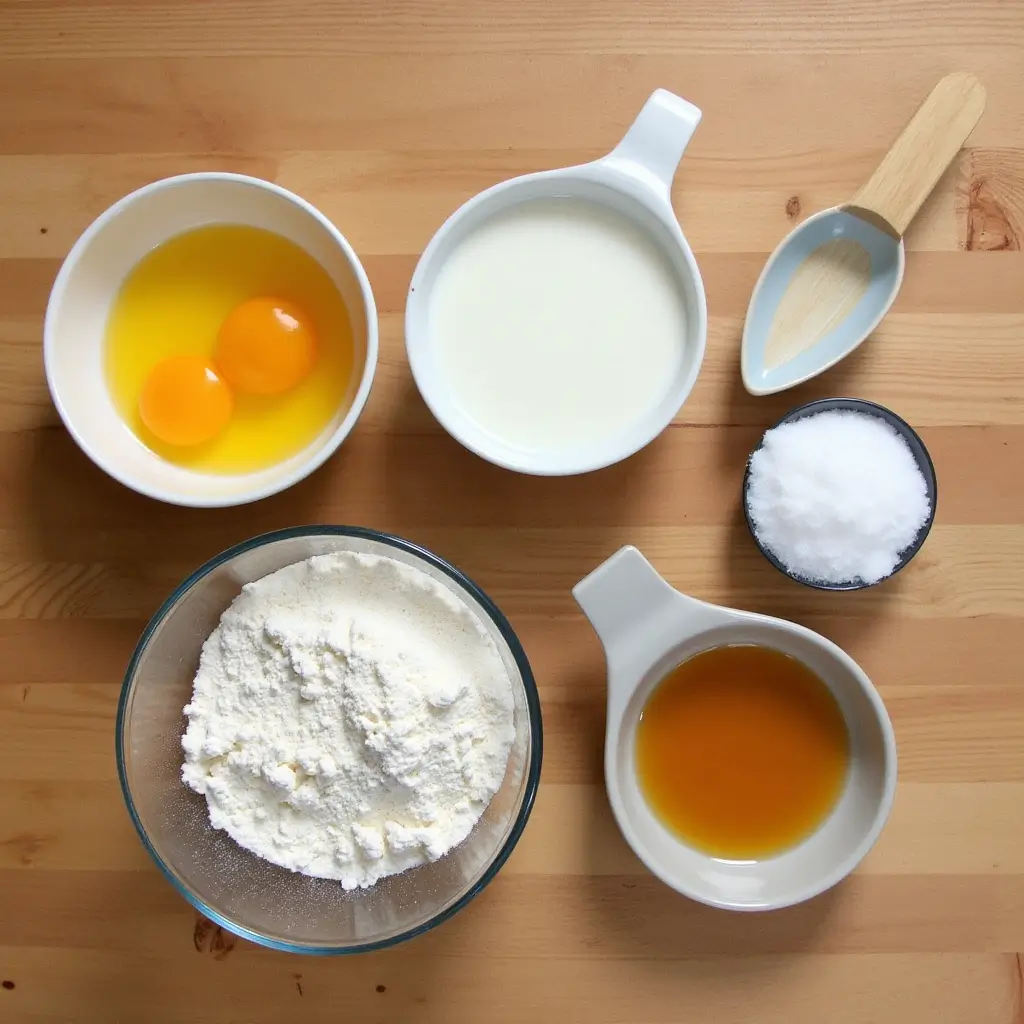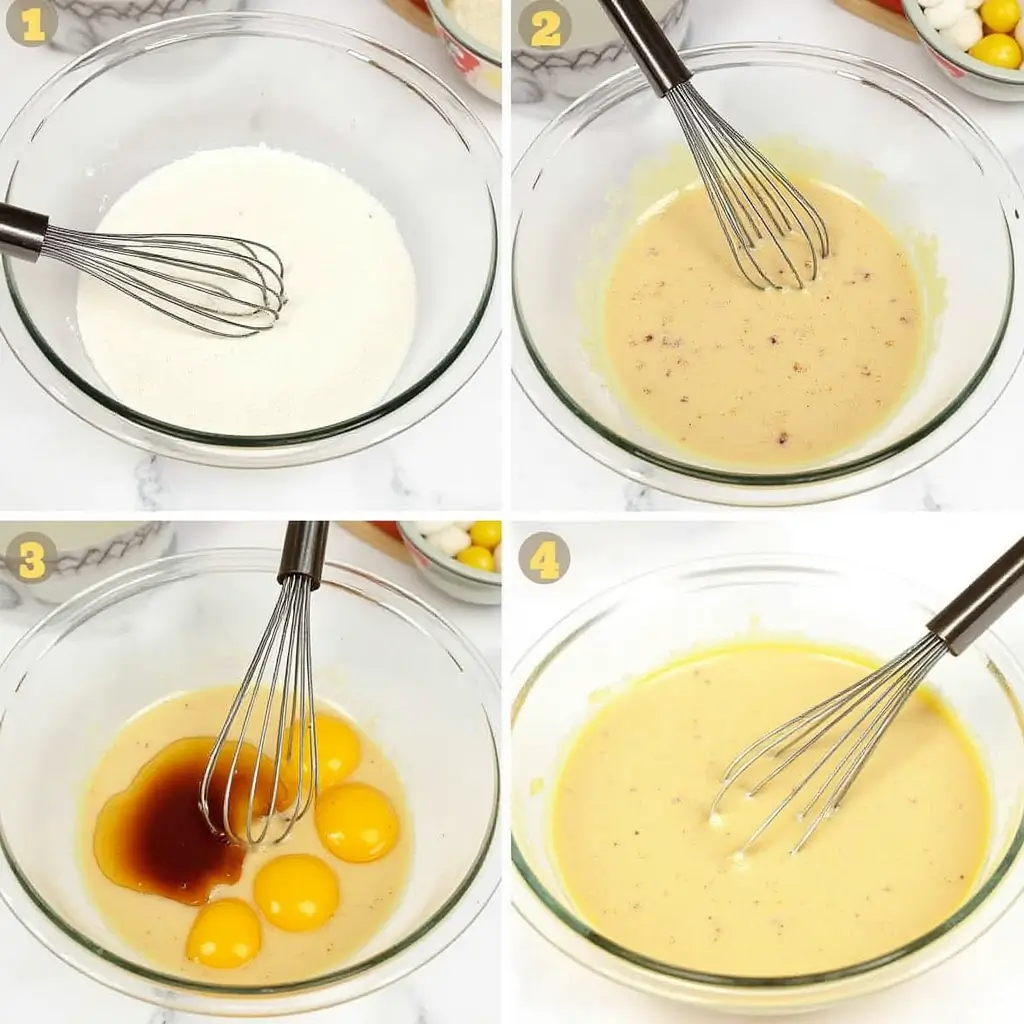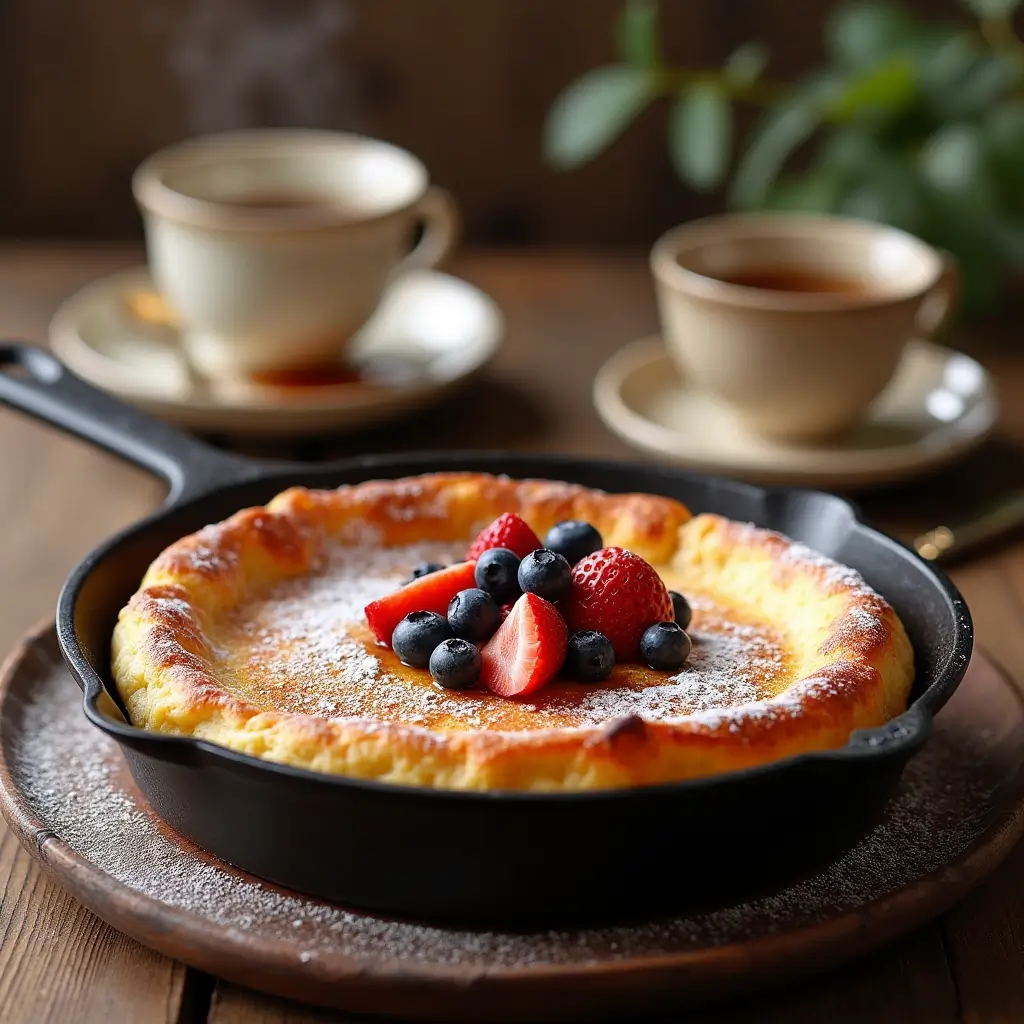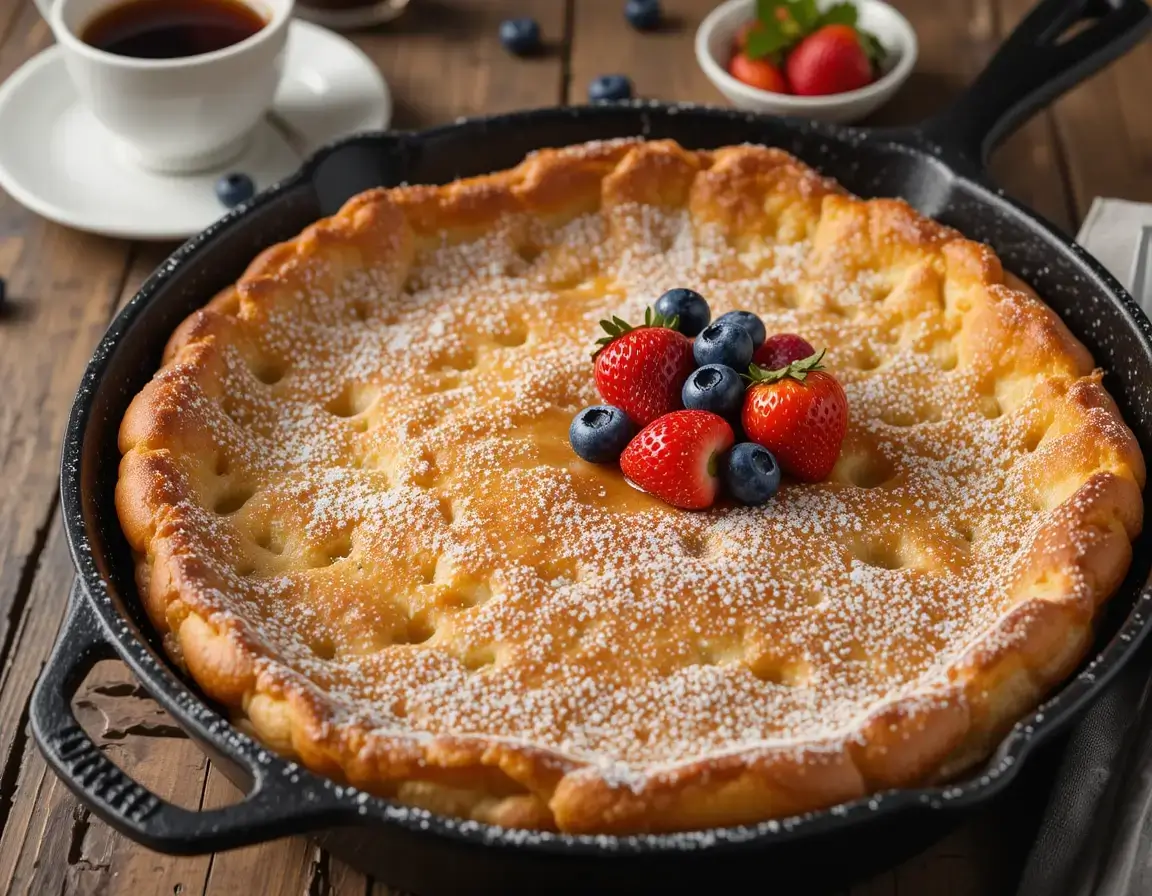A baked German pancake, also known as a Dutch baby or Bismarck, is one of those magical dishes that transforms simple pantry ingredients into something extraordinary. This dramatic, puffy creation rises spectacularly in the oven before settling into a tender, custard-like center with crispy, golden edges. Unlike traditional pancakes that require standing at the stove flipping batch after batch, this European-inspired treat bakes entirely in the oven, making it perfect for both leisurely weekend brunches and impressive yet effortless entertaining.
The Origins of the Baked German Pancake
Despite its name, the baked German pancake has a somewhat complicated lineage. Food historians believe it originated from the German Pfannkuchen, but the dish as we know it today evolved in America. German immigrants brought their traditional pancake recipes to the United States in the 1800s, and over time, these recipes were adapted to local ingredients and preferences.
Interestingly, the term ‘Dutch baby’ resulted from a mispronunciation of ‘Deutsch’ (the German word for German), leading to the confusing name for this German-origin pancake. The dish gained popularity in Seattle during the early 20th century at a restaurant called Manca’s Cafe, where the owner’s daughter reportedly couldn’t pronounce “Deutsch” properly, and the name “Dutch baby” stuck. Today, this versatile pancake is beloved worldwide for its impressive appearance and delicious taste.
What Makes a German Pancake Special?
What sets a baked German pancake apart from other breakfast dishes is its unique cooking method and resulting texture. The pancake begins as a thin, egg-rich batter that’s poured into a hot, buttered cast-iron skillet or baking dish. When placed in a hot oven, the heat causes the edges to rise dramatically while the center remains more custardy.
The magic happens through a combination of science and technique. The eggs in the batter provide structure and lift, while the high heat of both the pan and oven creates steam that helps the pancake rise. As it cools, the pancake will deflate somewhat, creating its characteristic crater shape – perfect for holding toppings.
Essential Ingredients for the Perfect German Pancake
The beauty of a baked German pancake lies in its simplicity. You’ll need:
- Eggs: These provide structure and contribute to the dramatic rise
- Milk: Adds richness and helps create a tender texture
- Flour: Just enough to hold everything together without making the pancake heavy
- Salt: Just a pinch brings out the natural sweetness and depth of the pancake
- Butter: For cooking and adding richness
- Vanilla extract: Optional but adds wonderful aroma and flavor

The ratio of eggs to flour is particularly important – more eggs create a more dramatic rise and custardy interior. Room temperature ingredients also help achieve the best texture, as they incorporate more easily and evenly.
The Perfect Baking Method
The key to a successful German pancake lies in the technique. Preheat your oven to 425°F (220°C) with a cast-iron skillet or oven-safe dish inside. This ensures that when you pour in the batter, it immediately starts cooking and rising.
Meanwhile, blend your ingredients until smooth – either with a blender, food processor, or vigorous whisking. Once the pan is hot, add butter and let it melt and slightly brown, then quickly pour in the batter and return it to the oven without delay.
The pancake will bake for about 20 minutes, during which time you’ll witness its dramatic transformation. Resist the urge to open the oven door during baking, as the drop in temperature can prevent the pancake from reaching its full, puffy potential.
Seasonal Variations and Toppings
One of the greatest virtues of a baked German pancake is its versatility. The basic recipe provides a perfect canvas for seasonal adaptations:
Spring and Summer
- Seasonal berries scattered across the pancake’s surface, finished with a gentle snowfall of confectioners’ sugar
- Lemon juice and zest with a drizzle of honey
- Sliced peaches or nectarines with a splash of cream
Fall and Winter
- Sautéed apples with cinnamon and brown sugar
- Poached pears with maple syrup
- Cranberry compote with orange zest
For a savory twist, skip the sugar and vanilla in the batter and top with:
- Crumbled beef and maple syrup
- Smoked salmon, cream cheese, and fresh dill
- Sautéed mushrooms and herbs with a sprinkle of Gruyère cheese
Nutritional Considerations
While a German Pancakes Recipe isn’t exactly healthy food, it does offer some nutritional benefits, particularly when topped with fresh fruits. The eggs provide high-quality protein and essential nutrients, while using whole milk adds calcium and vitamin D.
For those with dietary restrictions, the recipe can be adapted in several ways:
- Gluten-free flour blends can substitute for all-purpose flour
- Plant-based milks work well in place of dairy milk
- For lower fat versions, reduce the butter or use a heart-healthy oil
Common Troubleshooting Tips
If your German pancake doesn’t rise as dramatically as expected, consider these factors:
- Oven temperature: Make sure your oven is fully preheated
- Pan temperature: The pan must be hot when the batter goes in
- Batter consistency: Overmixing can develop too much gluten, preventing rise
- Ingredient temperature: Cold ingredients can inhibit rising
If the pancake sticks to the pan, ensure you’re using enough butter or oil, and consider the condition of your pan – well-seasoned cast iron works best.
Beyond Breakfast: German Pancakes for Any Meal
While traditionally served at breakfast or brunch, a baked German pancake can easily transition to other meals:
For lunch, top with a fresh salad of arugula, shaved Parmesan, and a light vinaigrette.
For dinner, fill with roasted vegetables and a sprinkle of cheese, or serve alongside a hearty soup.
For dessert, add a scoop of ice cream and a drizzle of chocolate or caramel sauce.
The Joy of Sharing
Perhaps the most delightful aspect of a baked German pancake is the communal experience it creates. Unlike individual pancakes that must be served in batches, a German pancake emerges from the oven as one impressive dish that can be brought straight to the table. There’s something inherently festive about watching people’s faces as they see the dramatic puff for the first time.
It’s also a perfect dish for teaching children about cooking – the transformation in the oven seems almost magical, and the relatively simple ingredient list makes it accessible for young helpers. The immediate gratification of watching something rise so dramatically keeps children engaged in the process.
A Recipe to Get You Started
Here’s a classic baked German pancake recipe to begin your journey:
Ingredients:
- 3 large eggs, room temperature
- ⅔ cup milk, room temperature
- ⅔ cup all-purpose flour
- ¼ teaspoon salt
- ½ teaspoon vanilla extract (optional)
- 2 tablespoons unsalted butter

Instructions:
- Place a 10-inch cast-iron skillet in the oven and preheat to 425°F (220°C).
- Add the eggs, milk, flour, salt, and vanilla to your blender and process until the mixture transforms into a silky, pourable consistency
- When the oven is hot, carefully remove the skillet and add butter, swirling to coat the bottom and sides as it melts.
- Pour the batter into the hot, buttered skillet and immediately return it to the oven.
- Let the magic happen for 20 minutes in the hot oven, watching as the batter climbs up the sides of the pan and takes on a beautiful golden hue.
- Serve immediately with your choice of toppings.

Conclusion
The baked German pancake stands as a testament to culinary simplicity transformed into something spectacular. With just a handful of basic ingredients and minimal hands-on time, you can create a dish that’s both visually impressive and delicious – perfect for gatherings or making an ordinary morning feel special.
Whether topped with sweet fruits, savory additions, or simply a squeeze of lemon and a dusting of sugar, this versatile pancake adapts to seasons, occasions, and personal preferences. As you master the basic technique, you’ll find endless opportunities to make this recipe your own.
So heat up that skillet, whisk those eggs, and prepare to be delighted by the magic of a perfectly baked German pancake – a dish that proves sometimes the simplest recipes create the most memorable meals.

Baked German pancake
Ingredients
Method
- Place a 10-inch cast-iron skillet in the oven and preheat to 425°F (220°C).
- Add the eggs, milk, flour, salt, and vanilla to your blender and process until the mixture transforms into a silky, pourable consistency
- When the oven is hot, carefully remove the skillet and add butter, swirling to coat the bottom and sides as it melts.
- Pour the batter into the hot, buttered skillet and immediately return it to the oven.
- Let the magic happen for 20 minutes in the hot oven, watching as the batter climbs up the sides of the pan and takes on a beautiful golden hue.
- Serve immediately with your choice of toppings.
Notes
- Calories: 195
- Fat: 9g
- Saturated Fat: 5g
- Cholesterol: 155mg
- Sodium: 185mg
- Carbohydrates: 20g
- Fiber: 0.5g
- Sugar: 3g
- Protein: 8g
Frequently Asked Questions
Why didn’t my German pancake rise as much as expected?
The key factors are temperature and timing. Ensure your oven is fully preheated, your pan is hot when adding batter, and you transfer it to the oven immediately. Room temperature ingredients also help maximize rise.
Can I make this ahead of time?
A German pancake is best enjoyed fresh from the oven when it’s at its puffiest. However, you can prepare the batter up to 30 minutes ahead and keep it at room temperature until ready to bake.
Is a cast-iron skillet necessary?
While cast iron provides ideal heat retention and distribution, any oven-safe skillet or baking dish will work. Glass pie plates and ceramic dishes are good alternatives.
Can I make this gluten-free?
Yes! Simply substitute your favorite cup-for-cup gluten-free flour blend. The eggs provide most of the structure, so the pancake will still rise beautifully.
How do I store and reheat leftovers?
While best fresh, leftovers can be refrigerated for up to 2 days. Reheat in a 350°F oven for 5 minutes or until warmed through. The pancake won’t regain its original height but will still taste delicious.
